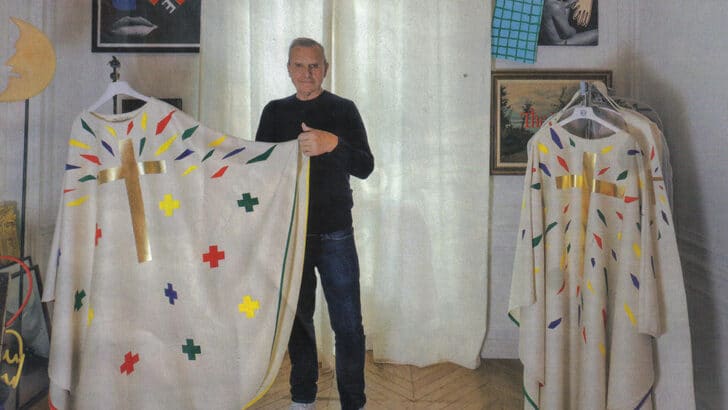Watching the ceremonies from Notre Dame, whether in the congregation or on television (where the view was better), for the occasion of the rededication of the great cathedral, many must have had their attention caught over the two days by the vestments worn by the participating clergy. These certainly struck a very different and new note.
Their creator was Jean-Charles de Castelbajac, a marquis of the old French nobility, a leading figure in the world of modern fashion design working for the great stars of the secular cosmos, is also a fervent Catholic.
Back in 1997 he dressed Pope John Paul II, the bishops and the priests for the World Youth Day held in Paris.
For the recent inauguration Jean-Charles de Castelbajac was chosen by the diocese of Paris to create the vestments for the 700 celebrants, composed of the Archbishop of Paris and bishops from all over France with their deacons and priests. A feature of his design were its primary colours, which have become a signal feature of the event.
“At Notre Dame I discovered the penitential shirt of St Louis, a kind of ‘tee-shirt’ of the XII century, which I recreated. It was this that launched my success,” he told Paris Match, discussing the vestments.
Since he came to live in Paris at the age of 17 in 1966 he has not liked to worship in his parish church, which he found to “classical”, but went always to Notre Dame, so his attachment to the place was of long date and deep appreciation.
Since the 17th century a pieta, a sculpture of the mother of Christ holding her crucified son, created by Nicolas Coustou, dominated the high altar. This masterpiece was flanked statue was flanked by images of Louis XIII on the left offering his crown and sceptre to her, and on the right Louis XIV praying. The cross, from which Jesus had just been taken down, in this setting had to exist only in the imagination of the devout.
{{Jean-Charles de Castelbajac was inspired by the post-fire press images of Marc Couturier’s cross. A golden cross appears on each of the white vestments”
However in 1994, the sculptor Marc Couturier won a competition to design a cross to be installed above this group. And this gold cross, which does not have the figure of Christ hanging on it, has become the centre of attention after the disastrous fire. Surrounded by the charred wreckage of the fallen roof beams, it shone out in the gloom of post-conflagration Notre Dame with startling glory.
Jean-Charles de Castelbajac was inspired by the post-fire press images of Marc Couturier’s cross. A golden cross appears on each of the white vestments – white being a colour traditionally linked to the liturgical season of holidays (Christmas, Easter, Ascension and so on).
This cross leaps out in the midst of bursts of yellow, red, blue and green – intended by the artist as an evocation of the stained glass windows of Notre-Dame, which remained in place.
Simplicity
He described his overall aim in straight forward terms. He hoped for a certain combination of beauty and humility, ornament and simplicity.
“A noble simplicity, refined yet almost epical. I aimed at the most beautiful but also the most humble… Something that would be at once medieval and ultra-contemporary. Rather than using the methods of the Middle Ages, I gave precedence to the artisanal techniques of today”.
In what he did he was conscious all the time of the role of what he was making in the rites, rituals and processions which are so important to the life of the cathedral.
In the event the vestments were certainly notable. They served, some observers felt, to demonstrate that the restoration was in fact a renovation, that they indicated that rather than shelter the past the Cathedral would inspire new developments in the understanding and appreciation of the Catholic faith.
At Notre Dame I discovered the penitential shirt of St Louis, a kind of ‘tee-shirt’ of the XII century, which I recreated. It was this that launched my success”


 Peter Costello
Peter Costello
